Discussions about the future of newspapers often allude to a moment in the Steven Spielberg film “Minority Report,” set in the year 2054, in which a commuter on the train is reading something that looks like a paper copy of USA Today, but which seems to be automatically updating and rearranging its contents like a web page. This is a comforting vision for the newspaper business: reassigning the un-bottled genie of the internet to the familiar commodity of the broadsheet. But as with most science fiction, the fallacy lies in the projection of our contemporary selves into an imagined future, when in fact people and the way they read may have very much changed by the year 2054.
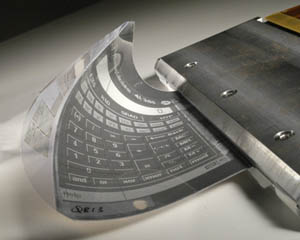 Being a newspaper is no fun these days. The demand for news is undiminished, but online readers (most of us now) feel entitled to a free supply. Print circulation numbers continue to plummet, while the cost of newsprint steadily rises — it hovers right now at about $625 per metric ton (according to The Washington Post, a national U.S. paper can go through around 200,000 tons in a year).
Being a newspaper is no fun these days. The demand for news is undiminished, but online readers (most of us now) feel entitled to a free supply. Print circulation numbers continue to plummet, while the cost of newsprint steadily rises — it hovers right now at about $625 per metric ton (according to The Washington Post, a national U.S. paper can go through around 200,000 tons in a year).
Staffs are being cut, hiring freezes put into effect. Some newspapers (The Guardian in Britain and soon the Wall Street Journal) are changing the look and reducing the size of their print product to lure readers and cut costs. But given the rather grim forecast, some papers are beginning to ponder how other technologies might help them survive.
Last week, David Carr wrote in the Times about “an ipod for text” as a possible savior — a popular, portable device that would reinforce the idea of the newspaper as something you have in your hand, that you take with you, thereby rationalizing a new kind of subscription delivery. This weekend, the Washington Post hinted at what that device might actually be: a flexible, paper-like screen using “e-ink” technology.
An e-ink display is essentially a laminated sheet containing a thin layer of fluid sandwiched between positive and negative electrodes. Tiny capsules of black and white pigment float in between and arrange themselves into images and text through variance in the charge (the black are negatively charged and the white positively charged). Since the display is not light-based (like the electronic screens we use today), it has an appearance closer to paper. It can be read in bright sunlight, and requires virtually no power to maintain an image.
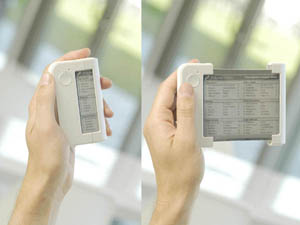 Frank Ahrens, who wrote the Post piece, held a public online chat with Russ Wilcox, the chief exec of E Ink Corp. Wilcox predicts that large e-ink screens will be available within a year or two, opening the door for newspapers to develop an electronic product that combines web and broadsheet. Even offering the screens to subscribers for free, he calculates, would be more cost-efficient than the current paper delivery system.
Frank Ahrens, who wrote the Post piece, held a public online chat with Russ Wilcox, the chief exec of E Ink Corp. Wilcox predicts that large e-ink screens will be available within a year or two, opening the door for newspapers to develop an electronic product that combines web and broadsheet. Even offering the screens to subscribers for free, he calculates, would be more cost-efficient than the current paper delivery system.
A number of major newspaper conglomerates — including The Hearst Corporation, Gannett Co. (publisher of USA Today), TOPPAN Printing Company of Japan, and France’s Vivendi Universal Publishing — are interested enough in the potential of e-ink that they have become investors.
But maybe it won’t be the storied old broadsheet that people crave. A little over a month ago at a trade show in Berlin, Philips Polymer Vision presented a prototype of its new “Readius” — a device about the size of a mobile phone with a roll-out e-ink screen. This, too, could be available soon. Like it or not, it might make more sense to watch what’s developing with cell phones to get a hint of the future.
But even if electronic paper catches on — and it seems likely that it, or something similar, will — I wouldn’t count on it to solve the problems of the print news industry. It’s often tempting to think of new technologies that fundamentally change the way we operate as simply a matter of pouring old wine into new bottles. But electronic paper will be a technology for delivering the web, or even internet television — not individual newspapers. So then how do we preserve (or transfer) all that is good about print media, about institutions like the Times and the Post, assuming that their prospects continue to worsen? The answer to that, at least for now, is written in invisible ink.
Category Archives: computer
kurzweil’s techno-narcissism
Ray Kurzweil looks into the future and sees the singularity gazing back full of love. It whispers. It seduces. “Ray, take care. Preserve yourself. It will be another 50 years yet. Go. Preserve yourself with vitamins, fruits, infusions. Keep your body tender and vital, and soon enough you will be subsumed, you will transcend. The singularity is near!”
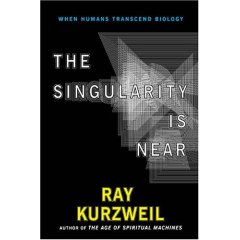 Kurzweil’s book is out and it’s as big as a dictionary. A good friend of mine was given it as a gift a couple of nights ago for his birthday. After dinner, as we rode the crosstown bus toward a game of cards, I read the first few pages. Try holding this goliath in one hand! The bus was crowded and we were standing in the aisle, gripping the handles on the top rail. The bus lurched, and I cursed my physiognomy. If only I could download the damn thing into my brain! If only the singularity were here now!
Kurzweil’s book is out and it’s as big as a dictionary. A good friend of mine was given it as a gift a couple of nights ago for his birthday. After dinner, as we rode the crosstown bus toward a game of cards, I read the first few pages. Try holding this goliath in one hand! The bus was crowded and we were standing in the aisle, gripping the handles on the top rail. The bus lurched, and I cursed my physiognomy. If only I could download the damn thing into my brain! If only the singularity were here now!
Kurzweil’s theory, or rather, his unshakeable conviction, his messianic belief, is that we, the human species, are nearing the point (he predicts around 2045) when our tools will become more intelligent than us and we will merge – mentally, biologically, spiritually – with them. Computer processing, artificial intelligence, biotechnology are all developing at an exponential rate (the law of accelerating returns), and are approaching a point of singularity, an all-encompassing transformative power, that will enable us to eliminate poverty, eradicate hunger, and “transcend biology.”
The reason Kurzweil is preserving his body – “reprogramming his biochemistry,” as he puts it – is because he is convinced that in about a generation’s time we will be able to ingest millions of microscopic nanobots into our neural pathways that will turn our brains into supercomputers, and engineer ourselves to live as long as we please. We will become, to borrow a conceit from an earlier book of Kurzweil’s, “spiritual machines.”
I would like to say that I will take the time to read his book and engage with it in more than a passing (and admittedly reactionary) way. Perhaps we’ll make a project of reading Kurzweil here at the institute as a counterpoint to Neil Postman (see recent discussion). But I’m not sure how much of his flaming narcissism I can take. Kurzweil’s ideas of “transhumanism” are so divorced from any social context, so devoid of any acknowledgment of the destructive or enslaving capacities of technology, and above all, so self-involved (the fruit and vitamin regimen is no joke – and there is probably a black monolith at the foot of his bed), that I’m not quite sure how to have a useful discussion about them.
As an inventor, Kurzweil has made many valuable contributions to society, including text-to-speech synthesis and speech recognition technology that has greatly aided the blind. It is understandable that his success in these endeavors has instilled a certain faith in technology’s capacity to do good. But his ecstatic, almost sexual, enthusiasm for human-machine integration is more than a little grotesque. Kurzweil’s website and book jacket are splashed with approving quotes from big name technologists. But I don’t find it particularly reassuring, or convincing, to know that Bill Gates thinks
Ray Kurzweil is the best person I know at predicting the future of artificial intelligence.
For a more reasoned, economic analysis of the possible outcomes of accelerating returns, read John Quiggins’ “The singularity and the knife-edge” on Crooked Timber. Another law – or if not a law, then at least a common sense suspicion – is that if the engine keeps accelerating and heating it up, it will eventually fall apart.
this laptop costs $100
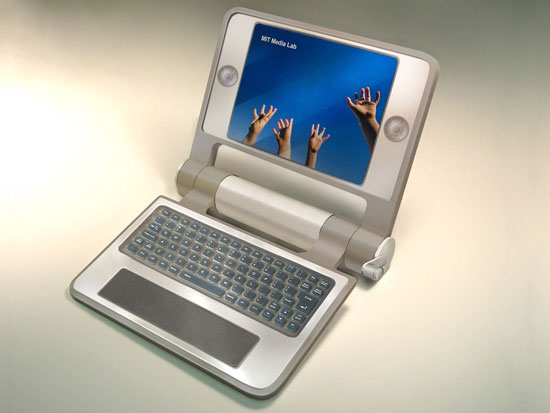
MIT has released some new images of its $100 laptop prototype, of which it hopes to have 5 to 15 million test units within the year. The laptops are much more durable than your average commercial machine, can be used as writing tablets or rotated 90 degrees as ebooks, and run on Linux – 100% free software. The idea is for the machines to provide a platform for an open source education movement throughout the South – a major hack of the current global order.
I love the hand cranks on the side, a backup charging option for remote or poorly provided areas where there is little or no electricity.
(“The $100 laptop moves closer to reality” in CNET)
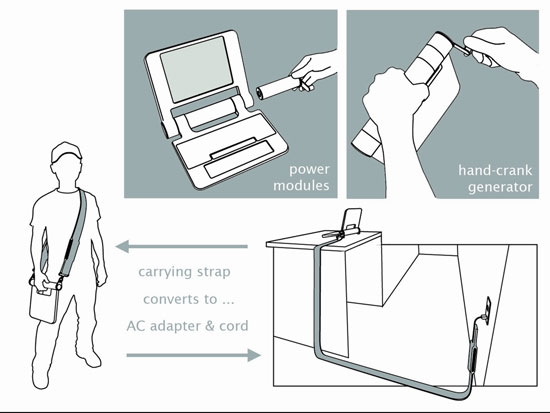
flash memory: “the digital paper age”?
Heads are spinning in response to Samsung’s planned release of a 16 gigabyte flash drive – a string of eight 2GB flash memory cards. Flash memory is solid state data storage, as opposed to the conventional hard drive, which contains spinning mechanical parts. The implication is that the price of memory for computers will soon drop dramatically, as will the amount of energy used to power them. Moreover, you will be able to carry millions upon millions of pages on something the size of a keychain (people will probably start using smaller ones as business cards before too long). There’s definitely something reassuring about the solidity – to rely entirely on a single, rickety hard drive, or a network, to store documents is incredibly risky and unreliable. Plus, these cards are far more tolerant of shocks, bad weather and all around abuse.
Chosun Ilbo describes the remarks of Hwang Chang-gyu, Samsung’s chief executive, who said:
…the development signaled the opening of the “digital paper age.” “In the same way that civilization rapidly progressed after paper was invented 2,000 years ago, flash memory will serve as the ‘digital paper’ to store all kind of information from documents to photos and videos in the future. Mobile storage devices like CDs and hard disks will gradually disappear over the next two or three years, and flash memory will dominate the information age.”
